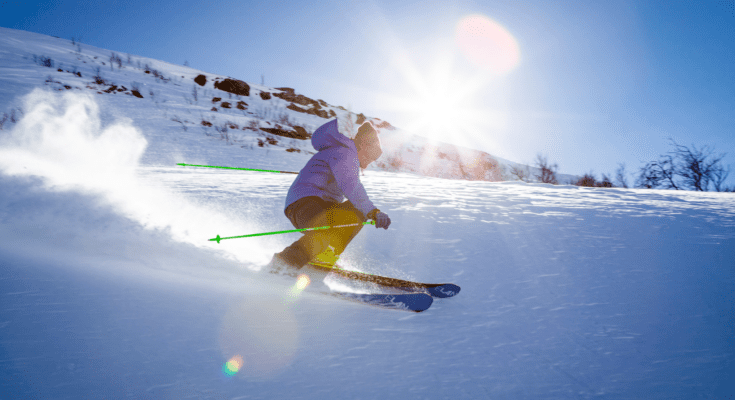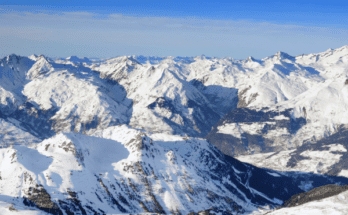Three tips to improve your skiing technique: Advanced
You’ve mastered the parallel turn and have no problems with edging your skis as you turn. You are already whizzing down fluffy red slopes, but haven’t dared to tackle the black ones yet.
Does this sound like you? Then it’s time to improve your skills with some advanced ski tips techniques for skiers who want to get better. It’s normally best to learn the next steps from a qualified ski instructor, however, you can always use a few tips to improve by yourself.
Whether it’s diving into fresh powder, moving over moguls, perfecting that dynamic short turn, or mastering a professional downhill on fast-paced runs – the beauty of skiing is that you can always learn and hone in on your technique! We have the best ski tips for advanced skiers for you to improve your technique even further, from intermediate to advanced. This will open up a fantastic new world for you on the mountain!
- Wizz down the slopes in short-swing ski turns
With the mastery of the short turn, you can venture into terrains that were previously hidden from you. Be it steep slopes, moguls or the supreme discipline: deep snow. Short turns are an excellent workout because you move faster and more powerfully than with regular skiing.
When you start practising short short-swing ski turns, it is best to start on a steeper slope at a slow pace. It is essential, especially in the beginning, to concentrate on the technique and not go too fast.
In the beginning, try a slightly wider leg position than you were used to in order to maintain a better balance. You will have to make faster movements, turn more and pay even more attention to your high-low movement when you wedel.
The most important thing with the short swing turn is that you don’t lean back too much. Otherwise, you won’t be able to control the fast turns and will fall backwards. You can read more about perfect posture when skiing here.
Skiers who suddenly get scared that they are going too fast tend to lean into a supine, horizontal position. This only makes the situation more difficult as you no longer control your skis; you’re either hurtling straight down or falling. So, remember to keep your upper body in front. Keeping your hands about ten centimetres in front of your body will help you avoid getting supine.
When skiing steep terrain, concentrate on your toes and press your shins forward against the boot. Hold your poles crosswise in both hands and stretch your arms slightly forward at stomach level to learn short turns. Make sure that your body centre, hips and belly are centrally above the skis.
When you slowly make the first turns, concentrate as usual on edging up the valley ski. However, now lift the mountain ski slightly at the same time. Immediately after completing the right-hand turn, switch to the left-hand turn. Put simply, leave out the glide in between.
When this is in place, you can use your ski poles normally again. It can be helpful to make a pole insertion before each turn. Even though stick insertion is now considered ‘old school’, it can help you avoid leaning too far back. If you feel confident with the short turns, you can stop the stressed transition and ski as normal, concentrating on increasing the load on the valley ski.
- Plunge into the depths of fresh snow
How to improve your advanced skiing technique in deep powder? For the most advanced and experienced skiers, deep snow skiing is the best thing beyond groomed slopes! It’s almost like flying, and learning this skiing technique opens you up to the world of freeriding. However, to be able to ski deep snow, it helps if you have a good command of the short turn.
When ploughing through powder snow, depending on how high it is, you will have to get used to the feeling a bit. This is because you actually have change your technique to get a bit supine here so that you don’t dive in too deep with the tips of your skis. Be careful not to shift your weight too much backwards, just a little.
Hold your skis with your heel at a slight angle so that the tips of your skis point slightly upwards. This will prevent your skis from dipping deep into the snow and make them easier to turn.
Speed is very helpful when skiing deep snow because the more speed you have, the more you seem to “fly” in the powder. If you are trying it for the first time, ensure there are no trees or other obstacles in your way if you don’t get the turns right away. If in doubt, go with a ski instructor or guide.
It might also feel a little unusual to distribute your load almost equally on both skis. If you put too much weight on the downhill ski or the outside ski, you may sink too much, or the ski may bind. The even load ensures buoyancy on the fluffy powder!
Once you have completed the first turns, do the next ones in the same rhythm. It would help if you did a clear up and down movement. This has a trampoline effect that really pushes you upwards. Short turns are particularly suitable for deep snow skiing.
Important!
Please note that the dream of deep snow skiing off-piste can quickly turn into a nightmare. Ensure there is no avalanche warning for the route and wear appropriate safety equipment such as an avalanche transceiver, helmet and avalanche backpack.
You should also never go off-piste alone, as it is difficult to find you there if something goes wrong. The best thing to do is to book an experienced mountain guide who will incidentally take you to the most fantastic off-piste routes available in the area. You will also need to check your insurance to ensure you are covered for any injuries.
- Master downhill skiing with the proper squat technique
Show that you are no longer a beginner with the right downhill squat on flat terrain. You’ll see it done incorrectly often enough, when amateurs tuck their poles under their arms on flat slopes, knees stiff, bottom stretched back and poles up while their upper body leans forward.
The correct position for a downhill squat is a less strenuous one than this beginner’s version. Try the squat while standing first, because it is not without effort! You will be able to feel the effort in your thighs very quickly and will now undoubtedly have much more respect for the downhill professionals!
To perfect this technique, squat deep into your knees and press your shins against the boot as hard as you can. Lower your rear until your thighs are parallel to the ground. Bend your upper body forward and angle your arms at a 45-degree angle.
Your poles should point backwards, parallel to the floor and not upwards. Your upper arms should be in front of your knees, with your hands are touching.
After some professional help, there’s nothing stopping you from hitting the black runs and freeride terrain! Once you have mastered these techniques, you can safely say that you are now an expert skier if you have mastered these three tips for skiing.
But as always, learning and improving your skiing technique never really stops! How about perfecting your carving technique next? Read more about it here. If you’d like some tips on which ski resorts to try next for your skiing and snowboarding, please visit our blog for more information on resorts, ski lessons, and lots of tips and tricks.




